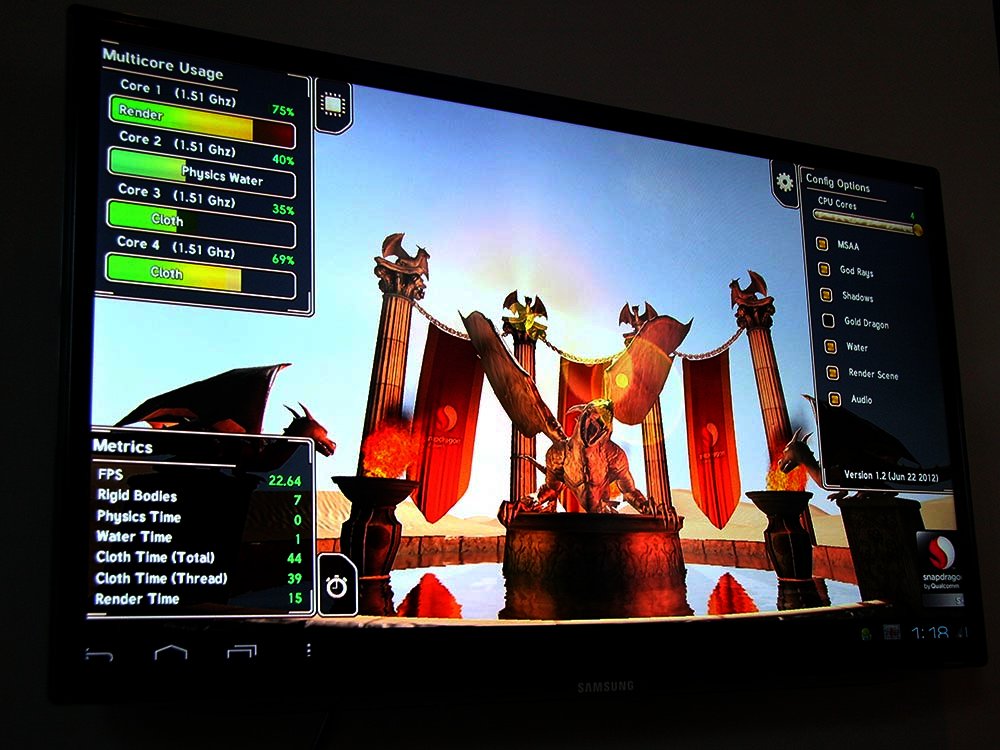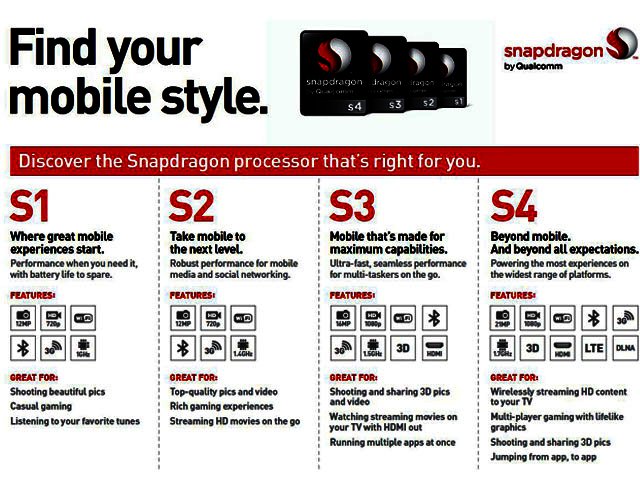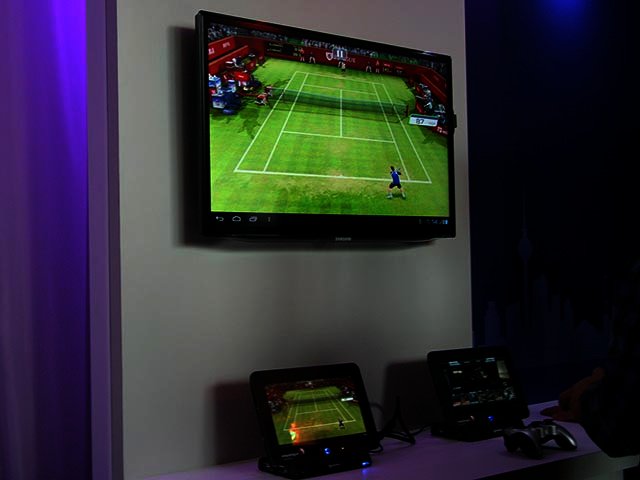PREVIOUS ARTICLENEXT ARTICLE
NEWS

Qualcomm reveals far-reaching changes ahead Part 2
By Ryan Noik 17 September 2012 | Categories: news
New opportunities
Other developments, which offer less serious impact, but are exciting nonetheless, include technologies such as Qualcomm’s AllJoyn, which provides a means for people to connect their disparate mobile devices, such at smartphones, tablets and notebooks, to each other, or connect to their peers, more quickly and easily, without the hassle of pairing.
Apart from the convenience this offers, AllJoyn also opens the door to some interesting opportunities for developers, and seamless collaborative experiences for mobile users.
Lauren Thorpe, Qualcomm’s senior director of business development, explained that AllJoyn could enable developers to turn apps into multi person experiences. For example, it could enable conference speakers to effortlessly push their slides to attendees, by merely using the same network to connect devices with each other.
Other developments, which offer less serious impact, but are exciting nonetheless, include technologies such as Qualcomm’s AllJoyn, which provides a means for people to connect their disparate mobile devices, such at smartphones, tablets and notebooks, to each other, or connect to their peers, more quickly and easily, without the hassle of pairing.
Apart from the convenience this offers, AllJoyn also opens the door to some interesting opportunities for developers, and seamless collaborative experiences for mobile users.
Lauren Thorpe, Qualcomm’s senior director of business development, explained that AllJoyn could enable developers to turn apps into multi person experiences. For example, it could enable conference speakers to effortlessly push their slides to attendees, by merely using the same network to connect devices with each other.
She added that AllJoyn could further provide impetus to developers to create apps that establish whether other people are around one and create a social platform. For example, game developers could use AllJoyn to turn games from single player to multi player experiences. These games would then function as single player offerings when no-one else is around, or offer a co-operative, or even multiplayer component, when AllJoyn detects others playing the same game.

Here, a graphically intensive scene is shown being rendered by the four cores of a Snapdragon processor. Most interestingly, the cores were only individually taxxed to the extent that they were needed.
Snapdragon - the heart of the matter
At the heart of all this promise is the company’s Snapdragon mobile processor. The processor is responsible for application processing, the length of the battery life on offer, and providing a multimedia and graphics experience via its integrated graphics processing unit.
The company also showcased its Fortress GPU (Snapdragon F4 Pro), using a tablet that boasted a quad core, Snapdragon processor. This dealt with a complex, and graphically intensive scene. In a desert landscape, flags wavered in the wind, dust particles floated across the sand’s surface, flames burnt and reflections in a reflecting pool rippled, all rendered in exquisite detail simultaneously.
In a hands-on demonstration, Vikrant Jain, the manager of business development at Qualcomm explained that, because Qualcomm makes its own components, it can optimise them to work together. As the scene was rendered, we could see in real time that each core would only use as much power as it needed for the task at hand, rather than all running at full capacity. This translated into less heat being generated, and a greater saving of one’s battery life.
The future beckons
However, as central as one’s smartphone already is to many people, Mollenkopf pointed out that today’s phone doesn’t do everything that it will in the future.
“In the years to come, phones will start to anticipate what you need and provide relevant data to you using the cloud,” he continued.
Indeed, the smartphone may act as one’s filter to, and lifeboat in, an expanding sea of information, providing one with the data that is most relevant and necessary to one’s unique needs.
At the heart of all this promise is the company’s Snapdragon mobile processor. The processor is responsible for application processing, the length of the battery life on offer, and providing a multimedia and graphics experience via its integrated graphics processing unit.
The company also showcased its Fortress GPU (Snapdragon F4 Pro), using a tablet that boasted a quad core, Snapdragon processor. This dealt with a complex, and graphically intensive scene. In a desert landscape, flags wavered in the wind, dust particles floated across the sand’s surface, flames burnt and reflections in a reflecting pool rippled, all rendered in exquisite detail simultaneously.
In a hands-on demonstration, Vikrant Jain, the manager of business development at Qualcomm explained that, because Qualcomm makes its own components, it can optimise them to work together. As the scene was rendered, we could see in real time that each core would only use as much power as it needed for the task at hand, rather than all running at full capacity. This translated into less heat being generated, and a greater saving of one’s battery life.
The future beckons
However, as central as one’s smartphone already is to many people, Mollenkopf pointed out that today’s phone doesn’t do everything that it will in the future.
“In the years to come, phones will start to anticipate what you need and provide relevant data to you using the cloud,” he continued.
Indeed, the smartphone may act as one’s filter to, and lifeboat in, an expanding sea of information, providing one with the data that is most relevant and necessary to one’s unique needs.

This chart dilineates exactly what users can expect from the Snapdragon family.
A Snapdragon for all
According to Cristiano Amon, the senior vice president and co-president of Qualcomm mobile and computing, the one thing that shows little signs of changing is what people want and expect from their smartphones – namely, that they should be powerful, offer consistent connectivity, and that they can last long periods away from a power outlet.
However, he made it abundantly clear that the company was committed to providing an affordable solution for every price point, particularly as feature phones were being replaced with entry-level smartphones.
Amon elaborated that in excess of 50 manufacturers were using Snapdragon processors in their products, while 420 Snapdragon products had already been announced. Additionally, another 400 designs with Snapdragon at their heart were in development, while 30 tablets were employing Snapdragon at their core.
Lasting impressions
Of the demonstrations we saw of the Snapdragon in action, a few stood out in particular. One of these was a Snapdragon equipped tablet running what looked like a next generation game on a fairly large screen, complete with controller.
However, rather than being pushed by an Xbox 360 or PS3, it was a 10” tablet, equipped with a quad core Snapdragon processor, delivering a superlative graphics experience. It’s not hard to imagine therefore, that next-gen graphics quality, coupled with Qualcomm’s AllJoyn technology, could well provide an uncompromising co-operative entertainment experience off a device small enough to carry around with one.

We were particularly impressed by how well the Snapdragon processor in this 10.1" tablet powered a game, which in this case could easily have been mistaken for running off an Xbox 360 or PS3.
Additionally, tantalising and real world applications for Augmented Reality, (which looks better each time we see it in action) as offered on the company’s Vuforia platform, has shown that innovation has become the order of the day.
Indeed, subsequent to our attendance at the conference, it was revealed by market research company IHS that the majority of memory chips were no longer being found in larger PCs. Instead, the company believes that smartphones and tablets will account for more than a quarter (25%) of the world’s memory by 2013.
Indeed, subsequent to our attendance at the conference, it was revealed by market research company IHS that the majority of memory chips were no longer being found in larger PCs. Instead, the company believes that smartphones and tablets will account for more than a quarter (25%) of the world’s memory by 2013.
To the point
As Qualcomm so clearly demonstrated, the shift towards mobile adoption; the power, performance and features that we can expect to enjoy from mobile devices, and the capability of the processors that power them, is going to grow exponentially.
As Qualcomm so clearly demonstrated, the shift towards mobile adoption; the power, performance and features that we can expect to enjoy from mobile devices, and the capability of the processors that power them, is going to grow exponentially.
In other words, thanks to the current and future crop of processors, the phrase from the title of Randy Bachman’s rock song “You ain’t seen nothing yet” may quite literally be true - and apt - when it comes to what users can look forward to from their mobile devices in the future.
USER COMMENTS
Most Read Articles
Read

Magazine Online
TechSmart.co.za is South Africa's leading magazine for tech product reviews, tech news, videos, tech specs and gadgets.
Start reading now >
Download latest issue
Have Your Say
What new tech or developments are you most anticipating this year?
New smartphone announcements (45 votes)
Technological breakthroughs (29 votes)
Launch of new consoles, or notebooks (14 votes)
Innovative Artificial Intelligence solutions (29 votes)
Biotechnology or medical advancements (24 votes)
Better business applications (160 votes)



